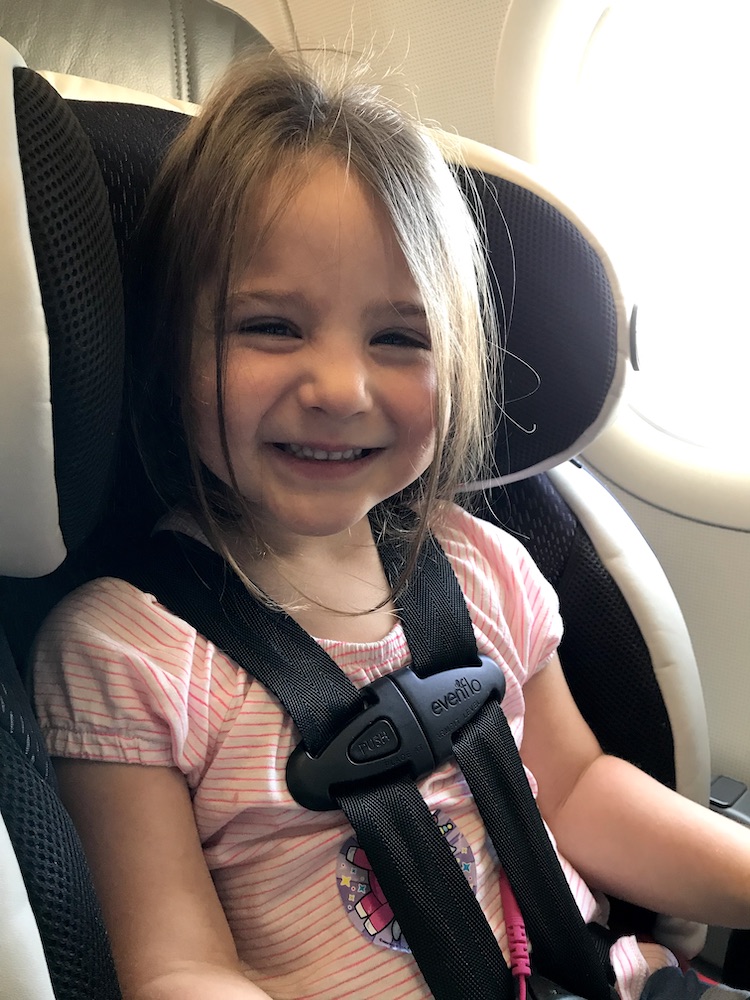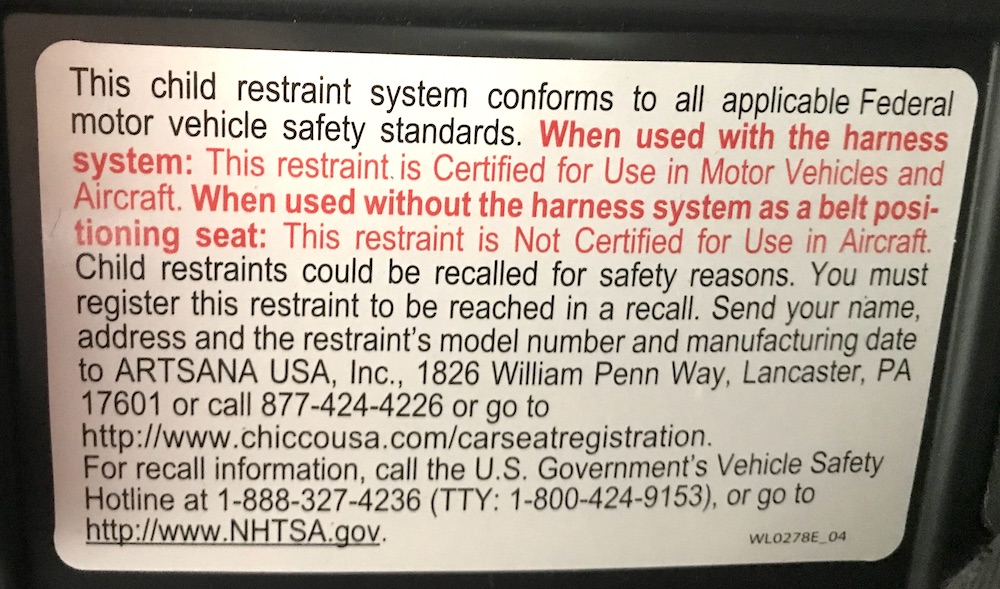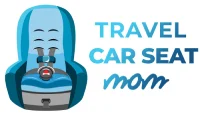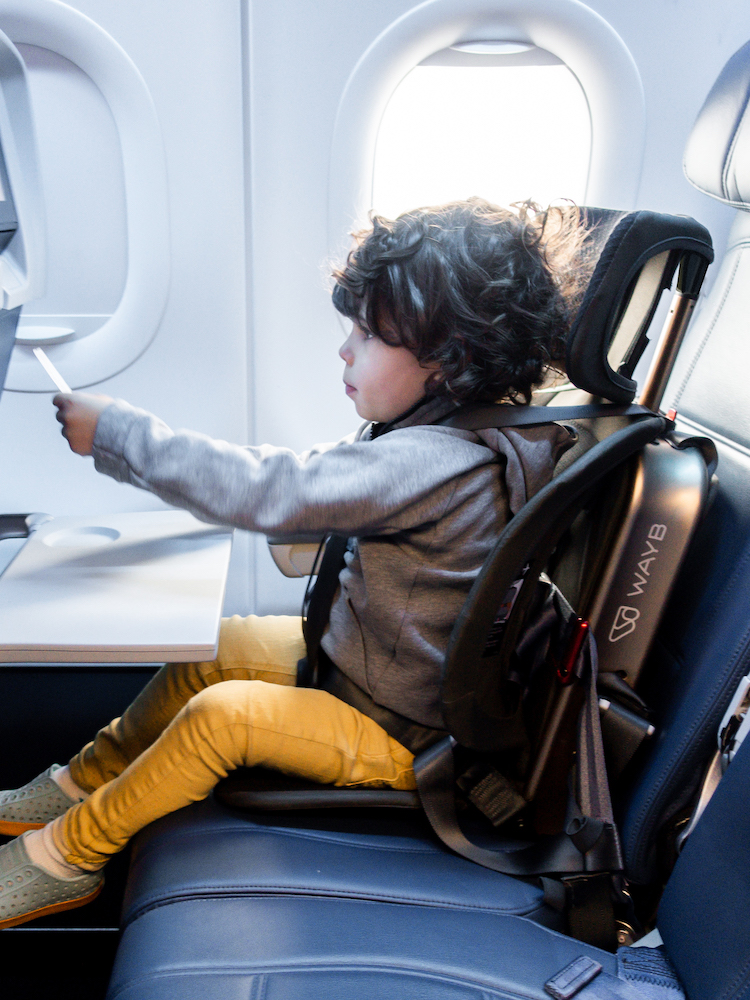This article about choosing an FAA approved car seat is written by certified Child Passenger Safety Technician Melissa Conn and may contain affiliate links.
There’s a lot of confusion out there in social media land about airline approved car seats. In this article I’ll explain which car seats you can and can’t use on an airplane, how to prove you have an FAA-approved car seat and more.
Which Car Seats Can’t Be Use On A Plane
As of this writing, there are very few American and Canadian car seats that can’t be used on a plane.
Nuna Pipa Lite (and Lite R/Lite LX) – These infant car seats are not approved for use on airplanes alone because they don’t have any way to be installed without the base. There is no seatbelt guide on the Nuna Pipa Lite or its newer cousin the Nuna Pipa Lite R (or Lite LX). The Pipa Lite, Lite R and Lite LX are now discontinued, so you won’t have to worry about this confusing issue if you’re shopping for a seat in 2023.
The new Nuna Pipa Lite RX does allow for baseless installation.
Update: Thanks to my astute reader Hannah who shared that the current Nuna Pipa Lite base is FAA-approved. If your base’s sticker says otherwise, contact Nuna to get a new one. You can install the base on the aircraft seat and then click your car seat in. That said, it’s still a very bulky option and may not fit well on airlines that have small seat pitch. For frequent travelers, I recommend that you check out one of these great travel infant car seats instead.
Cybex Sirona S – The ultra-fancy Cybex Sirona S convertible car seat is not approved for use on airplanes, as the airplane seatbelt isn’t compatible with the installation mechanism. Let’s not be all that sad, because it weighs 31 pounds and would be really cumbersome to try to install on a plane anyway. It also won’t fit in lots of airplane seats because it’s 20″ wide. You’re better off with one of these ultra-portable convertible car seats.
Baby Jogger City Turn – Yet another rotating car seat that can’t be used on the plane. It’s also enormous, so you wouldn’t want to!
Nuna REVV – Finally, in case you haven’t picked up on the theme yet, the all-new Nuna REVV rotating car seat is not FAA approved. This is understandable but a little disappointing given how compact it is.
Ride Safer travel vest – If you’ve read this site before, you’ll know how much I love the Ride Safer travel vest – check out my full review here. At present, the Ride Safer is not approved for airplane use. There’s been talk for maaaany years of an add-on to gain FAA-approval, but I’m starting to worry that it’s an urban legend. If you plan to use the Ride Safer for travel, it pairs well with the CARES harness for some kids – more info here.
All belt positioning boosters – Belt-positioning booster seats all require the use of a lap-shoulder belt, not a lap belt alone. There’s some murkiness about whether or not you’ll be able to use them in fancier classes (like Polaris) of service as they begin to integrate lap-shoulder belts, but thus far airlines have said “no”. However, if you’re bringing a “harnessed booster seat” on the plane – which we CPSTs generally call a combination seat – you can absolutely use it with the harness on your flight. You can see my lovely model below showing off her combination seat on a flight to Hawaii.
Read more: Flying with a booster seat

If you’re reading this article and you’re not American (or Canadian – our seats are usually the same though the specific rules may vary slightly up north), I’m sorry. Many car seats in other countries can’t be secured on planes.
There are a few reasons for this difference. First, many car seats made in other countries can be installed with either LATCH/UAS/ISOFIX or a seatbelt – but not both. If your car seat can only be installed with ISOFIX and the airplane just has seatbelts, you’re out of luck.
Second, some car seats (like Australian seats) require the use of a rear-facing tether. Australian planes often have a few of the required tether points at the back of the plane (which you need to reserve in advance on the phone), but planes in other countries won’t have them. Read more about bringing your car seat to Australia.
Third, many other countries just don’t have the same selection of ultra-compact travel car seats that the US has. There are numerous reasons why, but the net result is that plenty of non-US seats are just way too big to fit in skimpy American airplane seats. Some airlines like Spirit are explicit about the acceptable size of car seats.
What Are FAA Approved Car Seats
As you can see, the list of car seats that aren’t FAA approved is extremely short. Nearly every American car seat is approved for planes! Of course you’ll want to make sure you have the skinny on flying with a car seat before you take off.
New for 2023 the updated Evenflo Revolve 360 line is the only rotating car seat that is FAA-approved! While the top tether is required at all times in a car (forward and rear facing) you don’t need to worry about that on a plane. That said, it would be a very difficult seat to fly with so I don’t recommend it.
Airplane seatbelts don’t generally fit kids under 40lbs, so if you’re flying with a child smaller than that it’s recommended that you bring either a car seat or CARES harness to keep them safe. I recommend aiming for a narrow, lightweight car seat to increase the chances that it actually fits in the seat; we’ve never had an issue per se, but did come awfully close a few times – and that’s with car seats that are known to be good for flying.
If you’re shopping for an airline-approved car seat, you’ll want to look at these options depending on the age of your child:
- Best infant travel car seat
- Best travel car seat for a 1 year old
- Best travel car seat for a 2 year old
- Best travel car seat for a 3 year old
- Best travel car seat for a 4 year old
- Best travel car seat for a 5 year old
- Best travel car seat for a 6 year old
- Best travel booster car seat
Know Where Your Sticker Is
Before you head to the airport with your FAA-approved car seat, be sure you know where your airline approval sticker is and what it means. Sometimes it’ll be a label with tons of text, while other times it will have a picture of an airplane on it.
The worst is when it’s a sticker like the one below, which belongs to our family’s Chicco MyFit. The MyFit is FAA-approved when used in harness mode. As soon as you switch it to booster mode, it’s no longer approved. Some overzealous flight crew members may look at the second part of the red statement and ignore the first.
At some airlines (especially outside of the US) you may be asked to show the sticker at the check in desk, before you even get to security. Be prepared, be confident, and know your rights.

Can You Take A Car Seat On Non-US Airlines?

Airlines in the US and Canada are required to permit parents to use an approved car seat for their child if the child is occupying his or her own seat.
Read more: 10 Things You Need To Know Before Flying With A Car Seat
Outside of the US and Canada, however, it’s the Wild West. Every airline sets their own rules in Europe, Asia and beyond. Some don’t permit car seats at all. Some only permit forward-facing car seat. Some only permit car seats up to a certain age or have a specific airline approved car seat list (which may have an asterisk indicating that an FAA car seat fine).
Given the risks of traveling with a lap baby and checking a car seat, your best choice is to review an airline’s car seat policy before booking your tickets. Double-check which airline is operating flights, regardless of where you’re booking tickets. There were a few times when our family opted for slightly more expensive flights because they were on airlines that would allow us to secure our children in their car seats.
At this time there’s no centralized list of FAA approved car seats. You can consult your seat’s sticker or manual for more information.
While the TSA conducts security screenings before flights, they aren’t responsible for in-flight safety topics like airplane car seat approval. That said, when you bring your car seat through a TSA checkpoint you’ll need to run it through the typical scanning machine if it’s small enough or request hand inspection for larger seats.



Hi there!
I just wanted to reach out in regards to your comment about the nuna lite not being able to be installed on airplanes. You are correct that it cannot be installed baseless. But the base is FAA approved and if you contact nuna and southwest like I did, you are allowed to install the base. I went into a panic after reading your article as I have flights booked for this weekend. But I have double confirmed that you are indeed allowed to install the base. It is in their manual as well and nothing on airlines in the US prohibits base installations !
Thanks!
Hi Hannah,
Thank you so much for your comment! The Nuna Pipa Lite initially was not FAA-approved but it looks like that’s changed. I’ll update right away. I’m sorry for any confusion and really appreciate your reaching out.
Safe travels,
Melissa
Hi! I’m looking for guidance on how to install a forward-facing car seat on a plane. Is this very seat-specific or are there general guidelines you can share? Specifically I’m looking at purchasing a Cosco Scenera for my 2 year old, which you point out requires a top tether in cars – how does this work on a plane? Thanks!
Hi Gabrielle,
I’m glad you stopped by! Installing on a plane js really easy: run the seatbelt through the forward facing belt path (behind the child’s back), buckle and pull the tail to tighten! Some people use a seatbelt extender and align it so both buckles are outside of the seatback. Top tether isn’t needed on a plane.
HOWEVER, the Scenera isn’t a good choice for forward facing. The top harness slots are extremely low, similar to an infant car seat. Your 2 year old has probably outgrown the seat forward facing or is very close. I’d suggest that you look through these alternative travel car seats for 2 year olds. I’m happy to help with a specific recommendation if you share your child’s height and weight and if you also plan to forward face in the car.
Safe travels,
Melissa
Hi,
Nuna now has the Lite RX which can be installed with base or seatbelt. Are these now allowed on planes? Also, the seat is saying it is 17.5″ wide, but most seat widths on airlines are smaller. Have you heard of a car seat being denied based on that when you are already on board and getting settled? Thanks!
Hi Rachel,
The Lite RX is allowed on planes and should work great baseless! The only time I ever had an almost-issue with a car seat fitting was with a 19″ wide seat. Generally 17.5″ is no problem and you can put the arm rest up as long as you aren’t in the bulkhead row.
Safe travels,
Melissa